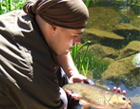
Caring for your Bushcraft Knives and correct usage
If you’re taking the time to read this article, then the chances are that you’re already an owner of some outdoors knives, or you’re planning on making an imminent purchase of a bushcraft knife, a tool that with proper care and correct usage will last you a lifetime.
So, how does one look after their cutting tools and bushcraft knives correctly? Well, the answer is to use each tool for its intended purpose. No matter how large the blade, no matter how strong the steel or thick the cutting tool, if the knife is being used incorrectly a breakage is possible with any bushcraft knife, large or small, cheap or expensive. Bushcraft knives and outdoor cutting tools are far from weak, but correct usage is a must if you want your tools to perform flawlessly and avoid unwanted risk of breakage.
How Not To Use Your Outdoor and Bushcraft Knives
There are several supposed bushcraft techniques that seem to be more responsible for damaging knives more so than others, and all is due to the fact that knives are not intended for these tasks. I have named and covered the main offending acts which can risk damage to your knives.
Battoning a Log - A Good Way to Break Your Bushcraft Knife
This, in my mind, is the main offender of breaking the blades of knives. Battoning is the act of placing the blade on top of a small log whilst striking the back of the blade with a hard object to split the log into two pieces. The blade is usually struck by another piece of wood, although I have seen examples of stones being used! Battoning is perfectly fine to do if the “log” has a small diameter, ideally nothing more than 1” (technically a large stick rather than log). IF you need to split logs, then use a dedicated tool, such as a bushcraft axe or a billhook, two tools which are designed for the sole purpose of chopping tasks.
Pry Bar – Not a Good Idea
Another common, and usually damaging area for knives, is that of using them as a pry bar. Unless designed especially for this, no knife should be used to pry open split wood, remove nails (or knock them in!). Having run courses and being involved in the knife business for many years, I’ve often seen knives with a very pronounced curvature to the blade due to improper use this way and almost always results in a flaw which cannot be corrected, if not resulting in a complete break of the blade.
Using Your Knife as a Striker
There is nothing wrong with using the back of the blade of your knife as a firesteel striker, but don’t use the cutting edge! Using the actual blade to strike the Ferro Rod will cause damage to the blade. Using the back will not cause any issues unless you light lots of fires this way, then I’d recommend using the striker supplied with the firesteel (if there is one).
Digging With a Knife – Yes, This Actually Happens!
Poking a knife about in the soil will undoubtedly cause problems and will inevitably clash with a stone which will damage the blade, and even if that doesn’t happen, the coarse nature of soil and grit will cause a dull (blunt) blade and possibly result in rust if not cleaned afterwards.
Caring For Your Bushcraft Knives and Sheath
It’s important to know the steel type of the knife that you are using. You can read about the steel differences by clicking here, but really all you need to know is if the steel type is “Stainless” OR “Carbon”. Stainless steel requires less attention, other than keeping the edge sharp and the blade clean. Carbon steel is a different beast altogether and will require regular maintenance to avoid rust and corrosion. Always oil carbon steel with a light oil when it’s practical to do so, and if being stored for a long period of time remove the knife from the sheath (if it’s a leather sheath) as the tanning may cause rust over time. Of course, if being stored out of the sheath, then make sure it’s still safe by keeping it in a box or something to avoid injuries.
As a general rule, stainless steel will require a little more sharpening than that of carbon steel, and is usually best achieved with a whetstone. It’s important to never let the knife go completely blunt as it will become harder to get a good edge back on the blade, but equally it’s important not to over sharpen or sharpen too frequently as this can make the knife too sharp and in turn the edge may become a little weaker.
Maintaining the qualities of the sheath is something that need not be done frequently, but leather sheaths will benefit from being kept dry and treated with some good quality shoe polish, leather cream, and wax or saddle oil.


COMMENTS
LEAVE YOUR OWN COMMENT